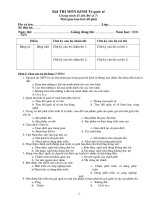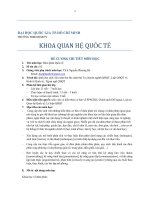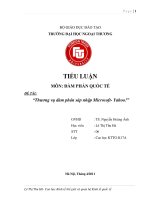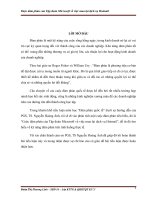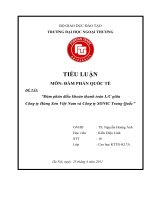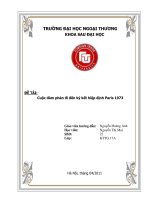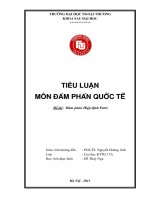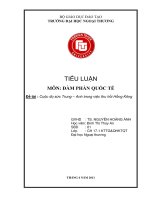slide đàm phán quốc tế ftu session 7 cross cultural negotiation
Bạn đang xem bản rút gọn của tài liệu. Xem và tải ngay bản đầy đủ của tài liệu tại đây (1.21 MB, 44 trang )
Session 7
Cross Culture Negotiation
CuuDuongThanCong.com
/>
Part 1
CULTURE AND NEGOTIATION
Differences in the expectations held by parties
from different cultures are one of the major
difficulties in any international business
negotiation.
2
CuuDuongThanCong.com
/>
The Pervasive Impact of Culture
on Negotiation Behavior
Companies and countries do not negotiate—people do
•
(1)
(2)
(3)
(4)
Cultural differences in international
negotiation can cause problems at
the levels of:
Language
Nonverbal behaviors
Values
Thinking and decision-making
processes
3
CuuDuongThanCong.com
/>
What is Culture?
• “Culture is the collective programming of the human mind
that distinguishes the members of one human group from
those of another. Culture in this sense is a system of
collectively held values.”
-- Geert Hofstede
• “Culture is the deeper level of basic assumptions and beliefs
that are shared by members of an organization, that operate
unconsciously and define in a basic ‘taken for granted’ fashion
an organization's view of its self and its environment.” -- Edgar
Schein
4
CuuDuongThanCong.com
/>
Elements of Culture
• What are the visible attributes of culture? What are the
elements that you can point to and say 'that is there to show
and sustain this culture'?
–
–
–
–
–
–
–
–
Artifacts
Stories, histories, myths, legends, and jokes
Rituals, rites, ceremonies, and celebrations
Heroes
Symbols and symbolic action
Beliefs, assumptions, and mental models
Attitudes
Rules, norms, ethical codes, and values
5
CuuDuongThanCong.com
/>
Culture as an Iceberg
Source: Adapted by Susan Schneider (HEC University of Geneva) from Schein, E. H.
(1985). Organizational culture and leadership, p. 14. San Francisco: Jossey-Bass.
6
CuuDuongThanCong.com
/>
Importance of Cultural Elements
• Notice these things, and how people react around them.
Beware of transgressing cultural norms unless you
deliberately want do to this to symbolize something (such as 'I
do not agree with this').
• Cultural rules are also very powerful levers. If you question
whether people are conforming, they will assert that they are
(and likely be concerned by your questioning their loyalty).
They can also be used as safety bolt-holes where people will
head for when threatened.
– Brown, A. Organizational Culture, Pitman, London, 1995 –
7
CuuDuongThanCong.com
/>
Hofstede’s Cultural Factors
1.
2.
3.
4.
5.
Power
Self
Gender
Predictability
Time
8
CuuDuongThanCong.com
/>
Power
• Hofstede named this Power Distance (PD or PDI). It is
the extent to which less powerful members expect
and accept unequal power distribution. High PD
cultures usually have centralized, top-down control.
Low power distance implies greater equality and
empowerment.
• Malaysia, Panama, and Guatemala rated the highest
in this category. The US was 38th.
9
CuuDuongThanCong.com
/>
Self
• Hofstede named this Individualism versus
Collectivism (ID or IDV). In an individual environment
the individual person and their rights are more
important than groups that they may belong to. In a
collective environment, people are born into strong
extended family or tribal communities, and these
loyalties are paramount.
• The US was number 1 here, closely followed by
Australia and Great Britain.
10
CuuDuongThanCong.com
/>
Power Distance and Individualism Profiles
Source: Hofstede, G. Culture’s Consequences: International Differences in Work-Related
11
Values,
CuuDuongThanCong.com
/>
Gender
• Hofstede named this Masculinity versus Femininity
(MAS). It focuses on the degree to which
“traditional” gender roles are assigned in a culture;
i.e., men are considered aggressive and competitive,
while women are expected to be more gentle and be
concerned with home and family.
• Japan led the list, followed by Austria and Venezuela.
The US was 15th.
12
CuuDuongThanCong.com
/>
Predictability
• Hofstede named this Uncertainty Avoidance
(UA or UAI). It defines the extent to which a
culture values predictability. UA cultures have
strong traditions and rituals and tend toward
formal, bureaucratic structures and rules.
Greece was number 1, followed by Portugal
and Guatemala. The US was 43rd.
13
CuuDuongThanCong.com
/>
Time
• Hofstede named this Long- versus
Short-term Orientation (LTO). It is
the cultural trait that focuses on
to what extent the group invests
for the future, is persevering, and
is patient in waiting for results.
• China led this dimension,
followed by its Asian colleagues,
Hong Kong and Taiwan. The US
was 17th.
14
CuuDuongThanCong.com
/>
Hall’s Cultural Factors
1. Context:
High vs. Low
2. Time:
Monochronic vs. Polychronic
3. Space:
The Need for Space
High Territoriality vs. Low Territoriality
15
CuuDuongThanCong.com
/>
Hall’s Cultural Factor:
Context
• High context
– In a high-context culture, there are many contextual elements that
help people to understand the rules. As a result, much is taken for
granted.
– This can be very confusing for person who does not understand the
'unwritten rules' of the culture.
• Low context
– In a low-context culture, very little is taken for granted. Whilst this
means that more explanation is needed, it also means there is less
chance of misunderstanding particularly when visitors are present.
16
CuuDuongThanCong.com
/>
Context
Contrasting the two:
• French contracts tend to be short (in physical length, not time
duration) as much of the information is available within the
high-context French culture. American content, on the other
hand, is low-context and so contracts tend to be longer in
order to explain the detail.
• Highly mobile environments where people come and go need
lower-context culture. With a stable population, however, a
higher context culture may develop.
17
CuuDuongThanCong.com
/>
Context Comparison
HIGH CONTEXT CULTURE
LOW-CONTEXT CULTURE
Many covert and implicit messages, with use
of metaphor and reading between the lines.
Many overt and explicit messages that are
simple and clear.
Inner locus of control and personal
acceptance for failure.
Outer locus of control and blame of others for
failure.
Much nonverbal communication.
More focus on verbal communication than
body language.
Reserved, inward reactions.
Visible, external, outward reaction.
Strong distinction between in-group and outgroup. Strong sense of family.
Flexible and open grouping patterns, changing
as needed.
High commitment to long-term relationships.
Relationship more important than task.
Low commitment to relationship. Task more
important than relationships.
Time is open and flexible.
Process is more important than product.
Time is highly organized.
Product is more important than process.
18
CuuDuongThanCong.com
/>
Hall’s Cultural Factor:
Time
• Monochronic time
– M-Time, as he called it, means doing one thing at a time. It assumes
careful planning and scheduling and is a familiar Western approach
that appears in disciplines such as 'time management'. Monochronic
people tend also to be low context.
• Polychronic time
– In Polychronic cultures, human interaction is valued over time and
material things, leading to a lesser concern for 'getting things done' -they do get done, but more in their own time. Aboriginal and Native
Americans have typical polychronic cultures, where 'talking stick'
meetings can go on for as long as somebody has something to say.
Polychronic people tend also to be high context.
19
CuuDuongThanCong.com
/>
TIME
MONOCHRONICATION
POLYCHRONICATION
Do one thing at a time.
Do many things at once.
Concentrate on the job at hand.
Are easily distracted.
Think about when things must be achieved.
Think about what will be achieved.
Put the job first.
Put relationships first.
Seldom borrow or lend things.
Borrow and lend things often and easily.
Emphasize promptness.
Base promptness on relationship factors.
20
CuuDuongThanCong.com
/>
Hall’s Cultural Factor: Space
• Hall was concerned about space and our
relationships within it. He called the study of
such space Proxemics.
• We have concerns about space in many
situations, from personal body space to space
in the office, parking space, space at home.
21
CuuDuongThanCong.com
/>
Space
The need for space
• Some people need more space in all areas. People who encroach into that
space are seen as a threat.
• Personal space is an example of a mobile form of territory and people
need less or greater distances between them and others. A Japanese
person who needs less space thus will stand closer to an American,
inadvertently making the American uncomfortable.
• Some people need bigger homes, bigger cars, bigger offices and so on.
This may be driven by cultural factors, for example the space in America
needs to greater use of space, whilst Japanese need less space (partly as a
result of limited useful space in Japan).
22
CuuDuongThanCong.com
/>
Space
High territoriality
• Some people are more territorial than others with greater
concern for ownership. They seek to mark out the areas which
are theirs and perhaps having boundary wars with neighbors.
• This happens right down to desk-level, where co-workers may
do battle over a piece of paper which overlaps from one
person's area to another. At national level, many wars have
been fought over boundaries.
• Territoriality also extends to anything that is 'mine' and
ownership concerns extend to material things. Security thus
becomes a subject of great concern for people with a high
need for ownership.
• People high territoriality tend also to be low context.
23
CuuDuongThanCong.com
/>
Space
Low territoriality
• People with lower territoriality have less ownership
of space and boundaries are less important to them.
They will share territory and ownership with little
thought.
• They also have less concern for material ownership
and their sense of 'stealing' is less developed (this is
more important for highly territorial people).
• People with low territoriality tend also to be high
context.
24
CuuDuongThanCong.com
/>
Culture Dimension in Negotiation
Cultural Dimension
Individualists/Competitors:
Collectivists/Cooperators:
Key goal is to maximize own gain (and
perhaps the difference between oneself
and others); source of identity is the
self; people regard themselves as free
agents and independent actors.
Key goal is to maximize the welfare of the
group or collective; source of identity is
the group; individuals regard themselves
as group members; focus is on social
interaction.
Influence:
Egalitarians:
Hierarchists:
Egalitarianism versus Hierarchy
Do not perceive many social obligations;
believe one’s value is determined by the
resources one can offer, usually economic
or intellectual.
Regard social order to be important in
determining conflict management
strategies; subordinates expected to defer
to superiors; superiors expected to look out
for subordinates.
Communication:
Direct Communicators:
Indirect Communicators:
Direct versus Indirect
Engage in explicit, direct information
exchange; ask direct questions; are not
affected by situational constraints; facesaving issues likely to arise.
Engage in tacit information exchange, such
as storytelling, inference-making;
situational norms.
Goal:
Individual versus Collective
Orientation
Source: Brett, J. (2007). Negotiating globally: How to negotiate deals, resolve disputes, and make decisions across cultural boundaries (2 nd ed.). San Francisco, CA:
Jossey-Bass.
25
CuuDuongThanCong.com
/>
